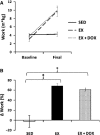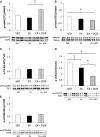Moderate-intensity treadmill exercise training decreases murine cardiomyocyte cross-sectional area
- PMID: 25991723
- PMCID: PMC4463834
- DOI: 10.14814/phy2.12406
Moderate-intensity treadmill exercise training decreases murine cardiomyocyte cross-sectional area
Abstract
The aim of this study was to examine the impact of moderate-intensity treadmill exercise on the structure and function of the murine heart and its associated impact on Akt-AMPK-mTOR signaling. A secondary aim was to test whether the exercise phenotype was altered following a cardiotoxic bolus dose of doxorubicin (DOX). Two-month-old C57Bl/6J female mice remained sedentary (SED, n = 12) or were progressively trained with treadmill running for 2 months up to 18 m/min; 60 min/day, 5 days/weeks (EX, n = 11) or EX + DOX (15 mg/kg/dose) (EX + DOX, n = 6). Following treadmill training, mice underwent graded exercise tolerance testing and echocardiography. Training improved graded exercise tolerance by 68 ± 5% relative to SED, and this effect was not altered with bolus DOX. There were no changes in relative heart size with EX or EX + DOX versus SED. Regional posterior wall thickening was improved in EX and abrogated in EX + DOX. EX had a reduced cardiomyocyte cross-sectional area (CSA) relative to SED, and CSA was further attenuated with DOX. Following EX, AMPK-associated phosphorylation of ULK1(ser317) tended to be lower relative to SED. Akt-associated phosphorylation of TSC2(thr1462) and mTOR(ser2448) were also decreased relative to SED. We observed an increase in AMPK activity with DOX that was not translated to downstream AMPK phosphorylation sites. We conclude that 2 months of moderate treadmill exercise training improves regional cardiac function and exercise capacity, but does not induce relative physiologic hypertrophy in female mice. Differential responses in Akt-AMPK-mTOR signaling may mediate the observed phenotype.
Keywords: Anthracycline; echocardiography; exercise training; heart; murine.
© 2015 The Authors. Physiological Reports published by Wiley Periodicals, Inc. on behalf of the American Physiological Society and The Physiological Society.
Figures




Similar articles
-
Concomitant low-dose doxorubicin treatment and exercise.Am J Physiol Regul Integr Comp Physiol. 2014 Sep 15;307(6):R685-92. doi: 10.1152/ajpregu.00082.2014. Epub 2014 Jul 9. Am J Physiol Regul Integr Comp Physiol. 2014. PMID: 25009215 Free PMC article.
-
Exercise Protects Skeletal Muscle during Chronic Doxorubicin Administration.Med Sci Sports Exerc. 2017 Dec;49(12):2394-2403. doi: 10.1249/MSS.0000000000001395. Med Sci Sports Exerc. 2017. PMID: 28767526
-
Short-term exercise training attenuates acute doxorubicin cardiotoxicity.J Physiol Biochem. 2015 Dec;71(4):669-78. doi: 10.1007/s13105-015-0432-x. Epub 2015 Sep 24. J Physiol Biochem. 2015. PMID: 26403766
-
Exercise training in doxorubicin-induced heart failure: effects on the L-arginine-NO pathway and vascular reactivity.J Am Soc Hypertens. 2010 Jan-Feb;4(1):7-13. doi: 10.1016/j.jash.2009.10.005. J Am Soc Hypertens. 2010. PMID: 20374946
-
Combined effects of exercise training and D-allulose intake on endurance capacity in mice.Physiol Rep. 2022 May;10(9):e15297. doi: 10.14814/phy2.15297. Physiol Rep. 2022. PMID: 35546434 Free PMC article.
Cited by
-
Systematic Review and Meta-Analysis of Endurance Exercise Training Protocols for Mice.Front Physiol. 2021 Dec 2;12:782695. doi: 10.3389/fphys.2021.782695. eCollection 2021. Front Physiol. 2021. PMID: 34950054 Free PMC article. Review.
-
Animal Models of Exercise and Cardiometabolic Disease.Circ Res. 2025 Jul 7;137(2):139-162. doi: 10.1161/CIRCRESAHA.124.325704. Epub 2025 Jul 3. Circ Res. 2025. PMID: 40608858 Review.
-
Preventive aerobic training preserves sympathovagal function and improves DNA repair capacity of peripheral blood mononuclear cells in rats with cardiomyopathy.Sci Rep. 2022 Apr 19;12(1):6422. doi: 10.1038/s41598-022-09361-z. Sci Rep. 2022. PMID: 35440673 Free PMC article.
-
Resistance training improves cardiac function and cardiovascular autonomic control in doxorubicin-induced cardiotoxicity.Cardiovasc Toxicol. 2021 May;21(5):365-374. doi: 10.1007/s12012-020-09627-w. Epub 2021 Jan 2. Cardiovasc Toxicol. 2021. PMID: 33387253
-
EFFECT OF AEROBIC AND ANAEROBIC TRAINING ON DIFFERENT ERGOMETERS IN RAT MUSCLE AND HEART TISSUES.Acta Ortop Bras. 2022 Dec 2;30(spe2):e248048. doi: 10.1590/1413-785220223002e248048. eCollection 2022. Acta Ortop Bras. 2022. PMID: 36506864 Free PMC article.
References
-
- Arad M, Seidman CE. Seidman JG. AMP-activated protein kinase in the heart: role during health and disease. Circ. Res. 2007;100:474–488. - PubMed
-
- Baltgalvis KA, Berger FG, Pena MM, Davis JM. Carson JA. Effect of exercise on biological pathways in ApcMin/+ mouse intestinal polyps. J. Appl. Physiol. (1985) 2008;104:1137–1143. - PubMed
-
- Baptista S, Piloto N, Reis F, Teixeira-de-Lemos E, Garrido AP, Dias A, et al. Treadmill running and swimming imposes distinct cardiovascular physiological adaptations in the rat: focus on serotonergic and sympathetic nervous systems modulation. Acta Physiol. Hung. 2008;95:365–381. - PubMed
-
- Bellafiore M, Sivverini G, Palumbo D, Macaluso F, Bianco A, Palma A, et al. Increased cx43 and angiogenesis in exercised mouse hearts. Int. J. Sports Med. 2007;28:749–755. - PubMed
LinkOut - more resources
Full Text Sources
Other Literature Sources
Molecular Biology Databases
Miscellaneous

